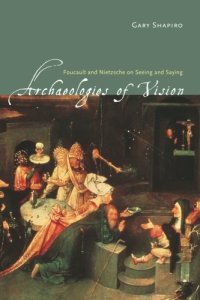
Ebook: Archaeologies of Vision: Foucault and Nietzsche on Seeing and Saying
Author: Gary Shapiro
- Tags: Reference Test Preparation Almanacs Yearbooks Atlases Maps Careers Catalogs Directories Consumer Guides Dictionaries Thesauruses Encyclopedias Subject English as a Second Language Etiquette Foreign Study Genealogy Quotations Survival Emergency Preparedness Words Grammar Writing Research Publishing Epistemology Philosophy Politics Social Sciences Humanities New Used Rental Textbooks Specialty Boutique
- Year: 2003
- Publisher: University of Chicago Press
- Edition: First Paperback Edition
- Language: English
- pdf
While many acknowledge that Friedrich Nietzsche and Michel Foucault have redefined our notions of time and history, few recognize the crucial role that "the infinite relation" between seeing and saying (as Foucault put it) plays in their work. Gary Shapiro reveals, for the first time, the full extent of Nietzsche and Foucault's concern with the visual.
Shapiro explores the whole range of Foucault's writings on visual art, including the theory of visual resistance, the concept of the phantasm or simulacrum, and his interrogation of the relation of painting, language, and power in artists from Bosch to Warhol. Shapiro also shows through an excavation of little-known writings that the visual is a major theme in Nietzsche's thought. In addition to explaining the significance of Nietzsche's analysis of Raphael, Dürer, and Claude Lorrain, he examines the philosopher's understanding of the visual dimension of Greek theater and Wagnerian opera and offers a powerful new reading of Thus Spoke Zarathustra.
Archaeologies of Vision will be a landmark work for all scholars of visual culture as well as for those engaged with continental philosophy.
Shapiro explores the whole range of Foucault's writings on visual art, including the theory of visual resistance, the concept of the phantasm or simulacrum, and his interrogation of the relation of painting, language, and power in artists from Bosch to Warhol. Shapiro also shows through an excavation of little-known writings that the visual is a major theme in Nietzsche's thought. In addition to explaining the significance of Nietzsche's analysis of Raphael, Dürer, and Claude Lorrain, he examines the philosopher's understanding of the visual dimension of Greek theater and Wagnerian opera and offers a powerful new reading of Thus Spoke Zarathustra.
Archaeologies of Vision will be a landmark work for all scholars of visual culture as well as for those engaged with continental philosophy.
Download the book Archaeologies of Vision: Foucault and Nietzsche on Seeing and Saying for free or read online
Continue reading on any device:

Last viewed books
Related books
{related-news}
Comments (0)